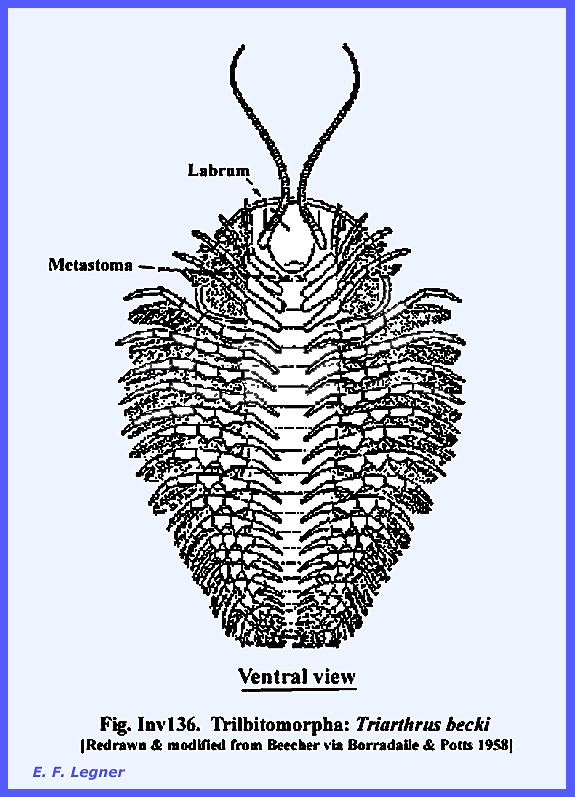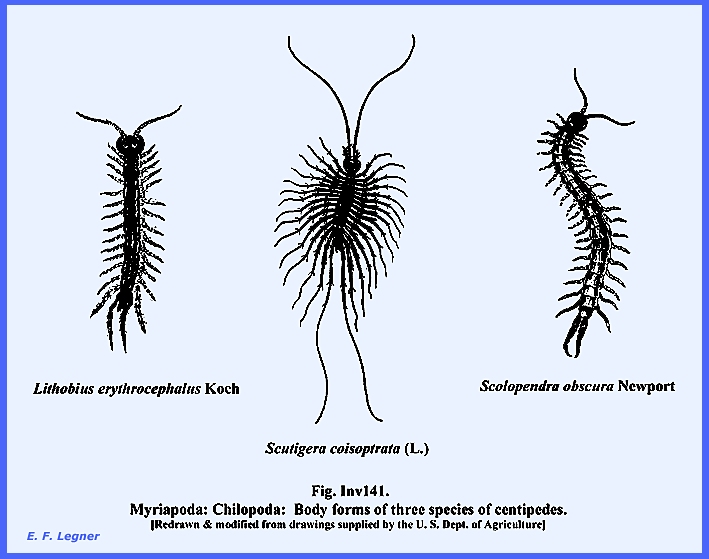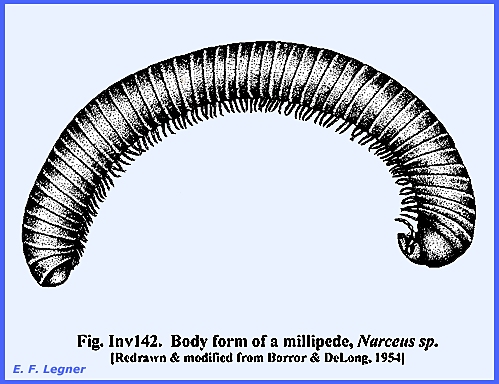File:
<arthropoda.htm> <Index to Invertebrates> <Bibliography> <Glossary> Site Description <Navigate to Home>
|
Invertebrate
Zoology Kingdom: Animalia, Phylum: Arthropoda (Contact)
CLICK on underlined
file names and included illustrations to enlarge: The Arthropoda
is the most highly developed phylum of the invertebrates, and they contain
the greatest number of species.
Included are such widely recognized groups as the insects, spiders,
crabs and barnacles. General characteristics are a
segmentation that varies in different parts of the body, often referred to as
heteronomous metamerism. There is a chitinous
exoskeleton, which is flexible but
horny and tough. It is always mixed
with other materials such as proteins and fats. They all possess jointed appendages,
one per segment, which are primitive and never fully functional. The body cavity is a haemocoel that
is not a true coelom. There are a
dorsal brain, ventral ganglia and nerve cord, and there is more nervous
tissue in the head than in the Annelida.
They have three body regions, which may be combined. The digestive tract is always of three
parts: (1) foregut, (2) mid gut and
(3) hind gut. The foregut and hindgut
are of ectoderm derivation while the midgut is derived from mesoderm. Molting is
required as the cuticle is a non-growing part. ------------------------------------ The Subphylum: Trilobitomorpha:
Class: Trilobita –
are an extinct group since the Paleozoic that is studied because they were probably
the most primitive of the Arthropoda.
Their body had a central region with a 3-lobed lateral area on either
side. They had a head and trunk and
were flattened dorso-ventrally.
Compound eyes were present and one pair of appendages occurred on every
segment of the body save the first.
Superficially they bore a close resemblance to the Branchiopoda and
also to the Brachyura crabs. Trilobites were marine organisms
and were numerous in the Cambrian and Silurian eras. They were mostly quite small at about 5
centimeters, but one fossil of Terataspis
sp. reached about 0.7
meters in length. The anterior
somites of a segmented trunk were movable on one another, while the most
posterior segments were united to form a tagma known as the pygidium. Their body could be rolled up like that of
an Isopod. It is thought that most
species lived at the bottom of the ocean in shallow to moderately deep water. However some species are believed to have
been adapted to pelagic, burrowing and deep-sea environments. It is known that trilobites
hatched as a larva, called the Protospis that
was a bit circular and consisted mostly of a head. See Inv136 for
example. ------------------------------------ Subphylum: Myriapoda, Class: Chilopoda includes
the centipedes. They are
dorso-ventrally flattened. Their body
consists of a head and trunk but there is no thorax nor abdomen. The head bears one pair of antennae, one
pair of mandibles, one pair of maxillipedes with
poison
glands at the bases and ducts
leading to pointed tips (Note: these
are absent in the Diplopoda). There
are two pairs of simple eyes called pseudocompound eyes. They have maxillae on the 1st and 2nd
segments. The trunk bears uniramous
appendages and there are 15 to 175 segments.
See examples at Inv141. Body
Wall -- This consists of a cuticle, muscles and
a haemocoel Digestive
Tract -- A typical mouth to
anus arrangement. Circulatory System
-- The heart is tubular with one pair of ostia per segment. The blood does not
carry oxygen Respiration
-- The tracheae are lined with ectoderm and cuticle, and heavy rings of
cuticle line them. They branch out
and ultimately reach all tissues of the body. The blood does not have an oxygen carrying function. Excretion
-- Malpighian tubules
are long, thread-like
and blind-ending tubules. They lie in
the haemocoel and empty into the digestive tract at the junction of the mid
and hindguts. They extract
nitrogenous wastes from the blood. Nervous
System -- This system is the
same as that found in the Crustacea. Reproduction
-- The sexes are separate. Genital
organs are found at the posterior end of the body and development is direct. Locomotion
-- These animals are fast movers.
Long posterior legs are sensory and used when moving backwards. Food
& Digestion -- Chilopoda are
carnivorous and their food is paralyzed first by the maxillipedes. ------------------------------------ Subphylum: Myriopoda,
Class: Diplopoda includes
the millipedes. These are cylindrical
animals with a head and trunk that is the same as in the Chilopoda. The head appendages include antennae,
mandibles, one pair of maxillae (instead of 2 pair as in the Chilopoda) and
pseudocompound eyes on the head. The
trunk has 25-100 or more segments with each segment bearing two pair of
appendages. A fusion occurs between
two segments all along the body except on the first trunk segment. See example at Inv142. Reproduction -- Genital
ducts open between the bases of the 2nd and 3rd legs. This is anterior in contrast to the
Chilopoda. Development
-- it is essentially direct except that the first larva has only three pairs
of legs with additions added later on. Food --
They are vegetarian animals that move very slowly and are harmless. ------------------------------------ ============== |


